Andrew and I are always looking for new outdoor adventures. One of his scouting requirements was orienteering. I knew a little about using a compass and we had studied community and geologic maps in school, but orienteering was a new combination for me. I did not feel qualified to teach myself, let alone Andrew. We needed help! While speaking with a local scoutmaster, I discovered an orienteering club in our area that had an upcoming event. I had no idea what we were getting into, but I knew we were in!
Orienteering Registration and Getting Started
It was 17 degrees when we showed at the orienteering event, however we were dressed and ready to go! To register, we filled out the paperwork and chose the easiest course. The club members were happy to have newbies and showed us what we needed to know. We received a course map, and a list of numbered controls at different checkpoints that we had to find along the course. We discovered we had to find these checkpoints in order, punch in our control key, take a new compass reading and then continue to the next control. A volunteer walked us to the starting point and showed us how to make sure our key was working. We got lots of encouragement as Andrew used the key to start our course timer, We were off!
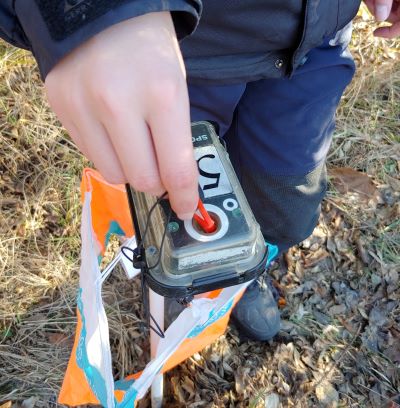
The Course
The easiest course followed the buildings or fencelines on the map and included a few trips through the woods and across a lumpy meadow. Not all course participants do the courses as a race, but being a bit competitive (well okay alot competitive) I got Andrew to jog some of it.
At each course point (marked with a circle on the map) there was a ‘numbered’ control marker. We checked our list to make sure we had arrived at the correct control. If the numbers matched, Andrew would insert the key and our check-in time was recorded with a beep. Then we would adjust the compass and head in the direction of the next circle marking our next check in point. What an awesome way to hike off trail!

We were hooked!
We had so much fun we decided to eat our sack lunch and then try the next level course. This time we knew what we were doing. However, after clumping through the first course in heavy winter boots, Andrew and I were both a bit tired, so we slowed our pace. The new course crossed a corn field. This is not a problem for most but it is for me, because arrowhead hunting takes precedence over race times! I found a preform (an arrowhead wanna-be that never quite made the cut) but nothing more for my efforts.
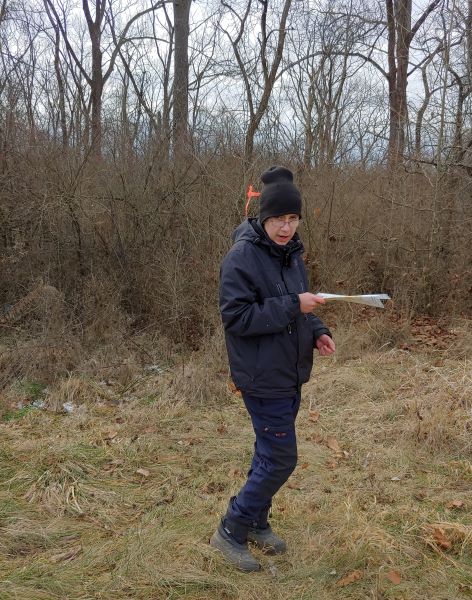
so we went my way — and got lost!
During course #2, I chose the wrong path and to get back on course, Andrew and I had to slide down a ravine, cross a partially frozen creek, and crawl up the other side. We could have taken the trail and backtracked, which would have been so much easier, but I knew the marker was on the other side of the ravine. To make up for arrowhead hunting we needed to cut corners, or in theis case ‘cut ravines’. While crawling up the other side, we ran into an elderly lady who asked if we had seen a control marker. We told her it was over the edge and it wasn’t ours so it must be hers. How awesome to meet a random senior in the middle of the woods!
Ready to find out more?
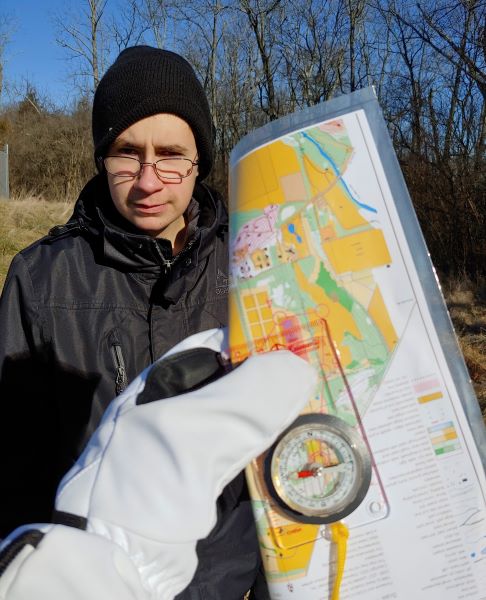
What is Orienteering?
There is a reason why they say orienteering is the sport of navigation. While on-course you have to follow a map using magnetic navigation and chose the best possible route to get to your next point. Direct is not always best route – that is where reading the map comes into play!
We discovered that orienteering is a sport for everyone. We saw families holding children by the hand, as well as seniors on the course. There were serious racers and those of us who were just learning. The event fell betweem 11 and 2 pm. Some participants pre-registered for a time slot while most of us showed up and registered the day of the event.
The controls electronically keep track of your course times, and because there are a multitude of courses, you never really see the participants you are competing against. So for those who lack competitiveness, which I absolutely can’t imagine, you have no worries.
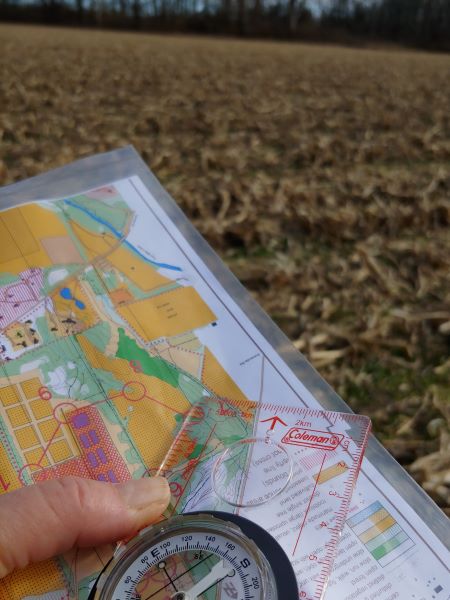
Navigation
I watched several ‘how to’ videos before we entered the orienteering event. I was concerned about how declination would affect navigation. Luckily, all orienteering maps align with true north, not magnetic north. By aligning the red north-south lines on the base compass and making sure you are holding the map with north pointing upwards, you dial the compass and set the direction following the path line on the map. Then you follow the arrow! It sounds more difficult than it is. My suggestion? Just jump in, get instructions, and just go for it. Seriously, it works itself out – and if you get a bit off course, who cares? Just have fun!
Gear and Clothing
- A baseplate compass. This is a compass with a platic base that has straight edges scales and rulers to use against a map.
- A Thumb Compass is also an alternative.
- A small first aid kit. Andrew developed a blister and luckily I had a couple bandaids to offer.
- Water bottles
- Backpack (I carry a small military tacticle sack)
- Protein bars or some type of snack.
- Lunches
- Dress appropriately: Orienteering events happen in all types of weather.
Note: Gloves were our biggest issues but at 17 degrees they were a necessity. Next time, I might try the type of mittens that fold back and velcro, leaving partially covered fingers.
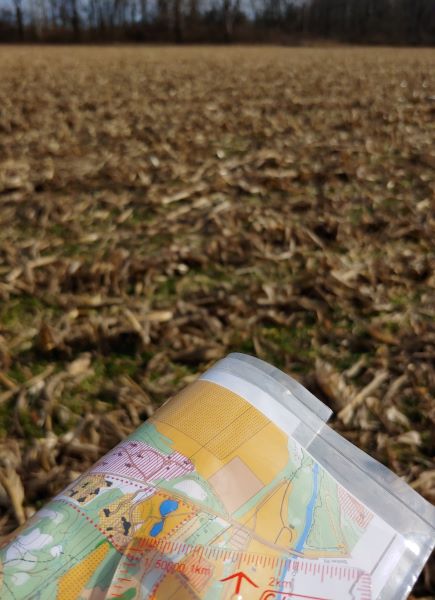
Where to find Orienteering Clubs
Search ‘orienteering clubs’ in your local area or go to Orienteering USA where you can find a list of clubs for your state. There are different types of events that are put on locally, nationally and even overseas. Check with your local parks, universities, or sporting businesses to see what they have listed, as well.
Do we plan to go orienteering again? ABSOLUTELY!
In the end, we came in third on the easy course and twelfth on the second! Timer aside, I would not have skipped arrowhead hunting! Overall the event was a blast and we are looking forward to doing a future event. Andrew and I both learned some new navigation skills, we covered 6 miles between the two courses, and counted it as PE for homeschool purposes.
Check out these posts:
Hiking and Getting Back to Nature


